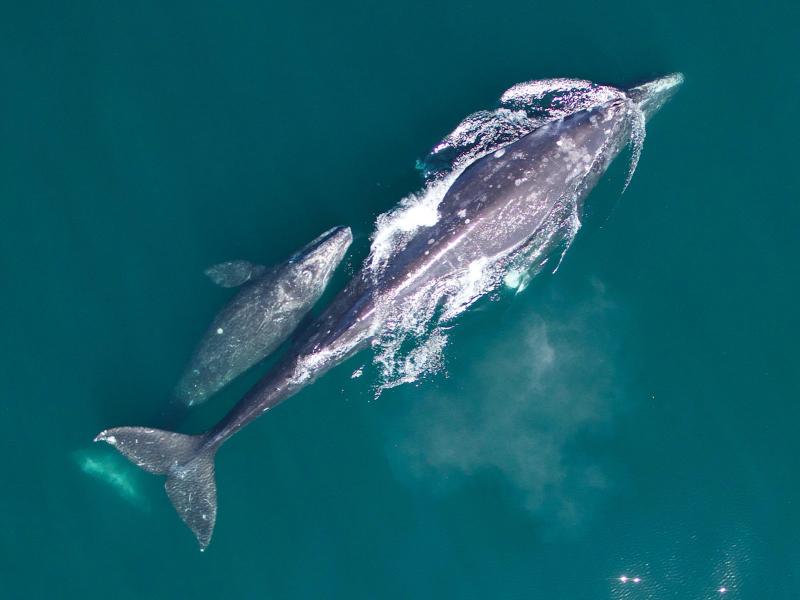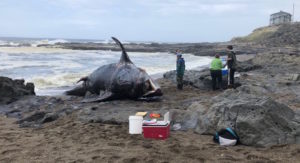
By QUINTON SMITH/YachatsNews
There’s good news for whale lovers on the Oregon coast.
The number of gray whales that migrated south along the Pacific Coast this winter have rebounded sharply to numbers not seen in four years, according to NOAA Fisheries.
The increase is large enough and signs of healthy North Pacific gray whales are visible enough that NOAA also announced last week it had ended its five-year “unusual mortality event” investigation into what may have led to their decline from 2018 through 2023.
The latest counts were conducted between late December and mid-February and released last week.

Researchers estimate there are 19,260 gray whales along the West Coast — a surprising 33 percent increase from the 14,530 whales counted during the same period of 2022-23. Last season’s count was the lowest since 1971-72.
Researchers have been counting whales during their southward migration since 1967 and use three months of visual surveys along the central California coast that are plugged into a formula used and refined for decades.
But a spokesman for NOAA Fisheries cautioned against reading too much into one year’s dramatic increase.
“People shouldn’t get too hung up on the 33 percent specifically but more importantly see that the numbers are increasing,” said NOAA spokesman Michael Milstein. “The numbers are trending up. The indications are consistent that the whales have gone from a decline to a recovery.”
That’s good news for scientists and whale enthusiast along the Oregon, Washington and California coasts.

The recovery is evident enough that NOAA officially declared an end to its five-year investigation into why many North Pacific gray whales appeared undernourished and why strandings increased starting in 2018.
NOAA’s investigation began in 2019 after hundreds of gray whales stranded along the Pacific coast from Mexico to Alaska, including in whales in their wintering, migratory, and feeding areas.
There was a roughly 40 percent decline in the gray whale population, leading to the official designation of an “unusual mortality event” which then triggered a required effort to understand why it was happening.
The mortality event occurred between December 2018 through last November, with peak strandings occurring during a two-year period ending in December 2020. There were 690 gray whale strandings, including 347 in the United States, 316 in Mexico, and 27 in Canada.

“While the number of strandings spiked at the start of the unusual mortality event, they have since declined to annual numbers similar to those recorded before the event began,” NOAA Fisheries said in a statement. “The number of calves born to the population also appears to be improving, with other signs that the population may have begun to recover.”
The number of calves born in 2022 was estimated at 217, down from about 950 in 2018. NOAA researchers estimate that 412 female gray whales swam north last year — nearly twice the 2022 count. Still, that number was far below the estimate of roughly 1,500 gray whale calves in 2016.
NOAA said the decline in gray whale numbers during from 2018 to 2023 resembled a similar but shorter decline between 1999 and 2000. The population rebounded in the following years eventually reaching a recent height of 27,500 whales in 2015-16 before declining again in 2019-20.
“We know the population has demonstrated strong resilience in the past, and we will be watching to ensure we know how the whales recover from this unusual mortality event,” said Deborah Fauquier, NOAA’s coordinator of the investigation.
Studies of dead whales supported malnutrition as a common cause of death and did not identify other causes or infections. NOAA investigators concluded that localized ecosystem changes, including both access to and the quality of prey, in the northern Bering and Chukchi seas contributed to the poor nutritional condition observed in live and stranded gray whales.
Killer whale predation, entanglement in fishing nets, biotoxins and collisions with vessels also contributed to gray whale deaths. But these factors were not as significant as malnutrition, researchers said.
NOAA said marine mammal stranding networks in the United States, Canada, and Mexico will continue to respond to whale stranding reports this year and collect samples when feasible. NOAA Fisheries will also conduct a survey this spring and summer to evaluate whale calf production.
“Carrying capacity” limits numbers
Gray whales were hunted to near extinction during the whaling era, but with the protections of the Marine Mammal Protection Act and the Endangered Species Act, the animals have recovered to the point where they were removed from endangered species protection in 1994.
The whales migrate in the spring from the warm waters of Mexico’s Baja peninsula to the icy waters of the Arctic and sub-Arctic, where they feed until they return to Mexico in the fall to birth their calves.
The kind of dramatic die-off that started in 2018 also occurred between 1999 and 2000 and two other times in the early 1990s, John Calambokidis, researching biologist and part of the group that investigated the recent unusual event, told the Los Angeles Times last week.
What he and other scientists found interesting, Calambokidis said, was the dramatic fluctuation in the gray whale population before the mortality event.
He said that when the whale population reaches the limits of the environment’s carrying capacity, there would be a decrease in the reproductive rate and a slight increase in the mortality rate that would bring the population to a plateau.
Gray whales seem to have gone through these more dramatic vacillations, he said, enduring three different periods of major mortalities and bouncing back before the most recent five-year event.
As gray whales recover to levels “that are near the limits of the food supply, then suddenly they become much more vulnerable to any fluctuations in that food supply,” Calambokidis told The Times.
Gray whale counts
2023-24: 19,260
2022-23: 14,530
2021-22: 17,430
2019-20: 20,630
2015-16: 27,450
2014-15: 23,440
2010-11: 20,820
2001-02: 16,033
1992-93: 15,762
1984-85: 23,499
1971-72: 11,079
1967-68: 13,426
-
To read more about NOAA’s “unusual mortality event” go here



